CONCORDMASSACHUSETTS |
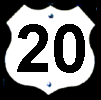 |
CONCORDMASSACHUSETTS |
 |
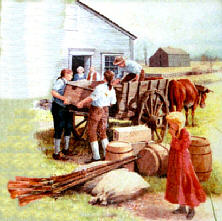 |
Growing Resistance The First Massachusetts Provincial Congress, in October, 1774, directed the establishment of the minute men, from existing militia. “...to enlist one quarter of ye least of the number of the respective companies, and form them into companies of fifty privates at the least who shall equip and hold themselves in readiness on the shortest notice…” By April 19, 1775, most towns in the colony had minutemen companies. The Provincial Congress also provided for purchase of arms and supplies, to be deposited in designated places. Concord was one of those places. (Concord Marker) |
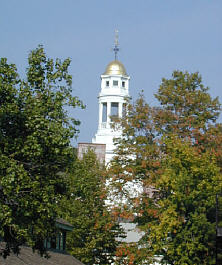 On a stretch of country road from Boston to Concord, a prolonged skirmish
between about 3,500 colonial militiamen and 1,700 British soldiers opened the
American Revolution. The initial fighting in the war was a local action between
Britain and her rebellious colony of Massachusetts. The government had clamped
down in reaction to the colony’s resistance to British economic policies.
On a stretch of country road from Boston to Concord, a prolonged skirmish
between about 3,500 colonial militiamen and 1,700 British soldiers opened the
American Revolution. The initial fighting in the war was a local action between
Britain and her rebellious colony of Massachusetts. The government had clamped
down in reaction to the colony’s resistance to British economic policies.
For
a year, the British army, under Gen. Thomas Gage, had occupied Boston. Pressed
by the ministry in London to quell rebellion by arresting Samuel Adams and John
Hancock, Gage chose instead to take away the patriots’ arms supply in Concord.
But incompetence and miscalculation doomed what he meant to be a limited,
routine operation. Gage depended on secrecy to seize the arms before the people
of Concord could resist, but Boston knew of the operation before his troops
left, and the arms at Concord were soon hidden. Couriers Paul Revere and William
Dawes notified Adams and Hancock in Lexington that the British were on their
way. Mix-ups delayed the British departure for hours, giving the colonists more
time to prepare.
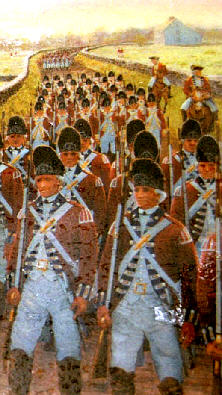 |
Concord: The British Objective General Gage, Military Governor of Massachusetts, received instructions from Great Britain to take action to stifle the growing flames of rebellion. Gage’s orders to the commander of the expedition to Concord read in part: Boston, April 18, 1775 Lieut. Colonel
Smith Sir: Having received intelligence, that a quantity of ammunition, provision, artillery, tents and small arms, have been collected at Concord, for the avowed purpose of raising and supporting a rebellion against his majesty, you will march with the corps of grenadiers and light infantry, put under your command, with the utmost expedition and secrecy to Concord, where you will seize arms, and all military stores whatever. But you will take care that the soldiers do not plunder the inhabitants, or hurt private property. Your most obedient humble servant Thomas Gage (Concord Marker) |
As the British troops marched down the road to Concord, news of a shooting at Lexington spread to neighboring communities and militiamen flocked to the British line of march between Boston and Concord.
At Concord, British soldiers began searching house-to-house for arms. Smith sent seven companies across the North Bridge to seize the supplies hidden at Col. James Barrett's farm.
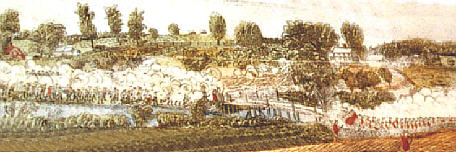
The colonial militiamen who had fallen back to Punkatasset Hill advanced on the three companies left to guard the bridge. As the militia approached, they saw the smoke of burning military supplies rising from town. Fearing that their homes were being put to the torch, they set out to save them.
After the British withdrew across the bridge the colonials continued to advance until the British fired a volley. Major Buttrick of Concord then gave the order, "Fire, fellow soldiers, for Gods sake, fire!” and for the first time Americans fired a volley into the ranks of British soldiers. The British, outnumbered four to one and with half of their officers wounded, retreated to the center of town.
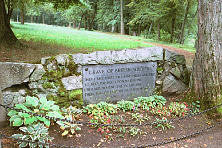 |
Grave of British Soldiers They came three thousand miles and died to keep the past upon its throne. Unheard beyond the ocean tide, their English mother made her moan. April 18, 1774 (Concord Marker) |
Today, at the center of town on the green is a monument to the brave men of Concord. A walk around the green is recommended, which includes markers for the Wright Tavern, the first meetinghouse and the Colonial Inn. North Bridge is about a half-mile drive past the Colonial Inn on Monument Street. A visit to North Bridge is recommended.
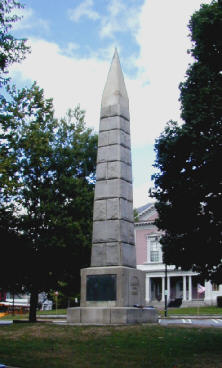 |
The town of Concord builds this monument in honor of the Brave Men whose names it bears and records with grateful pride, that they found here a birthplace, home and grave. 1866. (Monument Marker) |
Meriam's Corner -- The Meriam House is one of the oldest houses in Concord, Mass. On April 19, 1775 at Meriam's Corner, where the ridge ended, the British flankers had to be drawn in to cross the narrow bridge, Colonial militia, reinforced by companies from towns to the north, gathered near the road, taking cover where they could. Here began a running skirmish, which continued to Boston. The British encountered heavy, unrelenting fire from hundreds of militiamen behind buildings, walls, and trees, but the range was too great for the muskets to do much damage, and the British passed these areas with relatively few injuries. But British soldiers fell steadily at every hill or curve where the Americans had position. After the column had passed one spot, the militiamen would cut across country and be ready for them farther up the road.
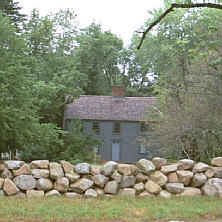 |
Meriam’s Corner The British troops retreating from the Old North Bridge were here attacked in flank by the men of Concord and neighboring towns and driven under a hot fire to Charlestown. (Meriam’s Corner Marker) |
Battle Road -- Today, to the east of the Meriam Home is the beginning of the Battle Road Trail connecting many of the park's historic sites, this pathway follows remnants of the historic road and also traverses farming fields, wetlands, and forests. The fields, farmed since the 17th century, made an unusual field of battle for the opening of the American Revolution. Much of that country road is now an urban highway, but the Battle Road still follows generally the same route, passing the sites of the bitterest fighting.
This route can be explored on foot, or by bicycle or wheelchair. The entire 5.5-mile trail is recommended on a longer visit to the area. However, a walk to and from the Bloody Angle marker is recommended. Here, you can view through a scope where the trail joins the historic Battle Road and where some of the most intense fighting occurred. Minutemen and militiamen set up an ambush and caught the British column in a crossfire from both sides of the road. When the smoke cleared, eight British soldiers lay dead.
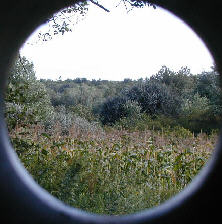 |
Farming Fields Farming fields in this area date back to the 17th century. These open fields provided little cover for the Colonists, who did not get close enough to inflict many casualties on the British column. From where you are now standing, a soldier in the road would be just beyond effective musket range. Many of the Colonists who took part in the North Bridge fight were joined here by men from the towns of Reading, Billerica and Chelmsford. They harassed the British troops with their musket fire. British flanking parties worked to keep the Colonists away from the main column in the road. (Battle Road Marker) |
Paul Revere's Capture -- A stone monument and several markers document the approximate site where the famous "midnight ride" of Paul Revere came to an end. As the markers indicate, Revere was captured and William Dawes turned back but Samuel Prescott escaped to carry the alarm to Concord. Near the capture site is a marker and stone outline of the former location of the Nelson House.
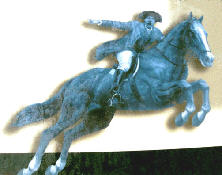
|
At this stretch of Battle Road, the
famous “Midnight Ride of Paul Revere” came to an end. While passing
through Lexington at around midnight, Revere and William Dawes met Dr.
Samuel Prescott of Concord, who was riding home after courting Lydia
Mulliken. Prescott agreed to help spread the alarm that “the Regulars
were out.”
The three men ran into a patrol of ten mounted British officers posted here to prevent word of the British march from reaching Concord. Revere was captured. Dawes escaped back toward Lexington. Prescott jumped his horse over a stone wall and eluded his pursuers. It was Prescott who carried the alarm to Concord and beyond. Revere was questioned, held for a while and then released, but the British officers confiscated his horse. Revere walked back to Lexington in time to hear gunfire at dawn on the town common. (Capture Site Marker). |
Minuteman National Historical Park and Visitor Center -- A stop at the center is recommended for the multimedia presentation as well as the exhibits. The section of the Battle Road near the Minute Man Visitor Center has been restored to a dirt and clay surface that is similar to the original surface of the entire road.
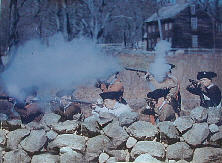 |
When the Regulars were within sight of
Lexington Green, they broke into a run. Only the arrival of Earl
Percy’s relief column of 1,000 troops averted catastrophe for the
British army.
Even with Percy’s help, the road to Boston was treacherous. The fiercest fighting was in Menotomy, now known as Arlington, where both colonists and Regulars inflicted considerable harm on one another. By the time British troops reached Boston harbor, they had suffered 273 casualties while the colonial losses totaled 94. (Minuteman Visitor Center Exhibit) |
